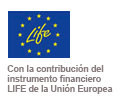Life + Regadiox (LIFE12 ENV / ES / 000426) presented on October, 2 at 9:15 a.m. at Casa Gurbindo www.casagurbindo.es
| UPNA is currently participating in a European project on sustainable management and reduction of greenhouse gas emissions in irrigated agriculture |
| The Soil Management Research Group studies the effect of different techniques to retain carbon in agricultural soils.
Carbon dioxide (CO2) in the atmosphere is used by plants to form their tissues and, when they die, carbon can reach the soil on which they grow. If we can optimize the way we cultivate the earth to prevent some of that carbon from returning to the atmosphere as CO2, we will be contributing to reducing the emission of greenhouse gases (GHG), one of the main causes of global warming and climate change. In this line of research, the Group has been working for ten years within the Soil Management Group of UPNA, which now participates together with INTIA and Fundagro in the European project called LIFE RegaDIOX. The project, launched last August, and [VAS1] coordinated by Fundagro, has a duration of three years. The main objective is to design, test and disseminate the impact that an improved model of sustainable management in irrigated agriculture can have in relation to CO2 sequestration and GHG emissions. Among other aspects, different indicators will be evaluated and analysed in order to estimate carbon sequestration, energy consumption and the amount of emissions generated in relation to soil handling, crop typology, irrigation systems, fertilisation, etc. UPNA researchers – Ms Paloma Bescansa, Mr Iñigo Virto and Mr Alberto Enrique, will be in charge of a very specific part of the project that is related to soil management. “We have been working for 10 years in the processes of incorporation and stabilisation of organic matter in the soil,” says Ms Paloma Bescansa. A new approach is related to the increase of carbon dioxide in the atmosphere and to how to retain part of that CO2 in the soil, in the organic matter that is deposited. In that sense, Mr Alberto Enrique explains how carbon fixation in the soil is a natural process, but when the soils began to grow, they lose some of the carbon they had managed to retain until then. “Organic matter is good for the soil. For example, think of a beech forest. The tree transforms the CO2 molecules into carbon chains, which form the leaf tissue. When that leaf falls to the ground, organic matter is very beneficial to the soil due to its chemical and physical fertility, etc. In the end it is transformed into nutrients, but in the meantime it generates a series of properties for the soil: it improves soil porosity, it allows the transport of water, etc. In many agricultural soils, this content is between 1 and 3%, which may seem very small but which nevertheless plays a very important role in the functioning of the soil”. Irrigation crops What the researchers are studying now is how to increase the contribution of natural carbon in the soil, through better treatment and management of arable land, water, etc. so that with a given soil and under specific climate conditions it can have an increased capacity for retaining CO2. “Having the soil to increase its organic matter content- indicates Iñigo Virto – can not only partially avoid that return of CO2 to the atmosphere but it also has advantages from the point of view of soil fertility whilst helping, for example, to reduce erosion. Agriculture, with different management systems, can influence the whole process and, in the case of irrigation, the soil may reach a greater carbon retention rate because we are somehow changing the conditions of previously non-irrigated soil and now the soil is going to have a greater water content. To put it in a nutshell, we could say that the organic matter potential of that soil in a semi-arid zone would be equivalent to that of a more humid zone”. Of the six actions scheduled under the RegaDIOX project, UPNA researchers will participate directly in three: On the one hand, they will compare traditional dry farmland with irrigated farmland; on the other hand, they will evaluate different systems of management of arable crops [VAS2] (non-permanent crops such as maize, horticulture, fodder, lucerne, etc.); and thirdly, in permanent crops, they will focus on vine and olive trees, being soils more prone to a management with or without plant cover. In this initial phase of the work, the researchers are selecting a series of parcels in the entire area affected by the Navarre Canal (areas that in the last fifteen years have been transformed into irrigated farmland) and characterising the soils. “We are going to check soil types, being one of the factors that have a larger influence in this entire process, and we will see how the quantity and type of organic matter in the soil evolves according to the different management-cultivation systems” explains Ms Paloma Bescansa. They will soon be joined by INTIA, whose work will focus on drawing up a balance of the energy used and GHG emissions associated with each agrosystem, so as to estimate the amount of energy used in a crop, the amount of fertilizers, the emission rate associated with that system, etc. “The idea,” as Mr Iñigo Virto puts it, “is to assess the widest possible range: water uses, management systems, fertilisation, etc., and to quantify the GHG balance associated with all the actions that have to do with irrigation”. Fundación Fundagro Foundation will capitalize on and stimulate the progresses made in the research and experimentation stages of the project in the agricultural sector so that they can be transferred to farmers for their practical application using techniques and management procedures whose effectiveness has been demonstrated. RegadiOX also includes studies on fertilisation, evaluation of irrigation systems (pressure, sprinkling, dripping, etc.) and the creation of pilot parcels where, by the end of 2016, work will be carried out in the final stage of the project. Note 1: You may contact Ms Paloma Bescansa for further information (by phone: [+34] 948 16 91 65; by email: bescansa@unavarra.es). Note 2: If you want a picture to complete the above information, you can download it from the website of the Public University of Navarre (http://www1.unavarra.es/actualidad/noticias). |

